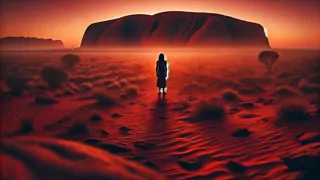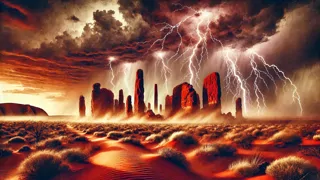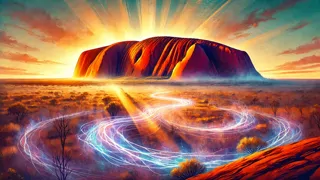Introduction
In the sun-scorched heart of Australia’s Red Centre stands Uluru, the towering red sandstone monolith that has witnessed the breath of countless generations. Known to many as Ayers Rock, this enigmatic outcrop holds the living memory of the Anangu people, where Dreamtime stories speak of ancestral beings whose voices stir in the winds and whose footsteps shaped every crevice of the desert floor. For tens of thousands of years, ritual songs and sacred ceremonies have echoed across the ochre plains, weaving a tapestry of spiritual connection between earth and sky, hearth and horizon. As dawn breaks and the first shafts of golden light wash across the face of the rock, spectral figures of guardians stir from their timeless slumber deep beneath the surface, emerging to watch over the land they forged. Their presence lingers in the rustle of spinifex grasses, the distant cry of wedge-tailed eagles, and the shifting hues of Uluru itself, which transforms from auburn to crimson to shadowed violet as the sun arcs overhead. Beneath the silent gaze of the Southern Cross, the guardians stand vigilant against threats to this sacred realm, summoned by a covenant older than memory. They trace their fingers along the fissures of the rock, infusing every vein with the essence of stars and ancient ancestors. Travelers who approach with a humble heart may see faint outlines dancing at dusk, a reminder that the living spirit of Uluru extends beyond stone into the very soul of the land. Their timeless vigil is a testament to the enduring bond between earth, sky, and the people who came before, a bond that teaches reverence, respect, and the delicate balance of life in one of the world’s harshest yet most beautiful landscapes.
Awakening of the Ancestors
As the first glow of golden sunrise unfurled across the vast ochre plains, Uluru stood like a guardian in silhouette, its red monolith embracing the nascent light with an ancient, steady patience. Within the bowels of this sacred sandstone, ancestral guardians—primordial spirits born from the Dreamtime—stirred beneath layers of compacted history, their forms woven from swirling sands, echoing crevices, and the hum of the desert’s heartbeat. Those elders of the earth possessed the shape-shifting grace of desert winds; at times, they emerged as towering, horned protectors whose shadows danced across the dunes, at others, they flowed as serpentine beings gliding through the spinifex and saltbush. Word of their awakening whispered among the mulga trees, carried on the backs of black cockatoos and wedge-tailed eagles, bearing their vigil to distant waterholes where drought and destiny intertwined. From the hush of dawn to the brightness of day, a spectral chorus of voices rose through the porous veins of the rock, chanting songs of creation and weaving threads of belonging between land, sky, and those who listened with humility. In those sacred moments, when sunbeams pierced the swirling dust, the monolith glowed with an inner fire as if the earth itself had been kindled by ancestral hands, and the guardians renewed their eternal oath to shield this land from neglect and harm. Every ripple of red sand seemed to pulse with echoed footsteps that once traversed the desert—footsteps that charted rivers, carved waterholes, and spoke the language of life into barren stone. For the Anangu people, the awakening of the guardians signaled a living promise: that the ancient covenant between sky spirit and earthly form would endure, preserving both story and soil for generations yet to tread beneath the Southern Cross. And as the desert air temperature climbed, that same fervor pulsed through every fold of the rock, affirming that beneath its stoic exterior, Uluru remained a living cathedral—a testament to the marriage of earth’s raw power and ancestral stewardship.

When the midday sun cast stark shadows upon the desert floor, the guardians convened along hidden pathways carved into the rock face, their voices humming in unison like rustling desert grasses bending before a breeze. Together, they breathed life into the boab and ghost gum, coaxing leaves to shimmer in emerald relief against the red backdrop and coaxing water to pool in secret hollows long forgotten. With a gesture broad as a sunbeam, they sculpted the courses of ephemeral rivers, guiding them through sunbaked channels so that wallaroos and kangaroos could quench their thirst in the brittle heat. Eagle spirits soared from their outstretched wings, weaving sunlight into aerial tapestries that painted stories of enduring legacy, while thorny shrubs and spinifex rose along the monolith’s flanks as testament to lessons learned from creation itself. Even the night sky bowed to their artistry, sparkling with constellations that mirrored ancient painting motifs—each star a guardian’s eye, each constellation a verse in the Dreamtime saga. They walked unseen among wandering travellers, offering gentle guidance through impassable dunes and warning those who ventured with careless intent to measure their footsteps against the rhythm of the land’s heartbeat. When a careless foot disturbed sacred ground, the guardians murmured through rattling pebbles and crackling twigs, admonishing with invisible hands that revered spirits lay beneath every grain of loamy dust. By moonlight, when the desert cooled to silver stillness, they gathered at the foot of Uluru, weaving circles of starlight into the air, renewing sacred covenants in silence that transcended time and memory. Thus, with each cycle of sun and moon, the guardians wove their presence into every leaf, every grain of sand, every breath of wind, ensuring that this red heart of the outback would never forget its own stories.
Yet even in this realm of sacred harmony, shadows of greed and negligence emerged from distant horizons, where machines roared and steel wheels gouged the earth with indifferent precision. Whispers of proposed roads and mining shafts drifted across the desert winds, unsettling the guardians and stirring dust storms that threatened to bury promises born in the Dreamtime. In the darkest hours before dawn, a thunderous clamor rose as if the rock itself had convulsed, heralding the guardians’ response to encroaching dangers that would scar both land and lore. They gathered at the monolith’s crest in somber counsel, their eyes ignited with indignant fire, and with resonant chants, they summoned winds fierce enough to erode the advance of cold metal and forced steel. A tempest of swirling red sand rose in pillars that rivalled the monolith’s height, wrapping those who had come to desecrate the land in a cloak of ancestral authority, bending their resolve before it could solidify into action. But their power was tempered by mercy—a lesson etched in every canyon and valley—so that those who listened with respect found their tools wrenched from their grasp and their hearts moved by an unseen wisdom. Under the watchful gaze of the Southern Cross, the guardians dreamt new patterns into the rock, sealing fissures and erasing signs of intrusion until the monolith stood untouched once more. Travelers awakened to silence and empty skies, no evidence of conflict remained save for the lingering hum of the Dreamtime, a quiet reminder that this domain belonged to voices older than any map or treaty. And so, the guardians upheld the fragile balance between man and spirit, ensuring that Uluru remained a testament to reverence, resilience, and the sublime power of ancient bonds.
Echoes in the Red Earth
Long after the guardians receded into the labyrinth of subterranean caves that crisscross beneath Uluru, their presence lingered like an echo in the red earth, resonating through every crevice and cavern. Pulses of ancient song danced along the sandstone walls, marking sacred sites where ochre pigment imprints formed intricate maps to water, ceremony, and communal memory. Each footprint pressed into the fine-grained dust carried a tale of kinship between the Anangu and the land, a covenant woven from the delicate threads of reciprocity and respect. Spirits of ancestral ancestors manifested as fleeting shapes in the midday haze, guiding kin and creature alike toward hidden billabongs and secret springs fed by subterranean streams. In the rustle of dried seed pods, one could hear faint warnings of drought, in the flutter of cockatoo wings, a lullaby urging patience until the rains returned. Plants that drew sustenance from the porous rock anchored themselves in living prayer—roots entwined with ancient veins, a testament to the guardians’ enduring artistry. During moonlit nights, constellation patterns flickered in the sky as if the guardians painted them anew, offering navigation to desert dwellers wandering by starlight. Artisans of time and stone, the guardians carved their legacy into the horizon, ensuring that every echo of wind through a narrow gorge would repeat the name of their sacred watch. And travelers who paused to listen often claimed they could decipher whispers of counsel—gentle reminders that this land thrived through balance, not conquest. In the interplay of sun and shadow, the red earth yielded its secrets to those who approached with humility, reaffirming that wisdom lies in the quiet acceptance of mysteries older than memory.

Centuries later, when explorers first glimpsed Uluru’s fiery form against a blanched horizon, they felt an inexplicable pull—an invitation to witness something that transcended mere geology. Yet few discerned the depths of living myth that pulsed beneath each sun-baked surface, mistaking the silent sentinel for a curiosity rather than a temple of ancestral power. Early maps inscribed lines that sliced through ceremonial grounds, until soft murmurs of protest and Dreamtime lore swelled like distant thunder, halting progress with the weight of timeless authority. Missionaries, surveyors, and government emissaries all encountered the same unspoken boundary, as if the land itself reeled back to protect its most sacred heart. Whispered warnings cascaded through tent lines and dusty camps, carrying tales of vanished equipment, disoriented beasts, and gloved hands scorched by unseen flames. Indigenous custodians stepped forward with quiet dignity, sharing stories of ancestral stewardship that sounded like songs of the wind, teaching that true possession arose from kinship, not conquest. In response, the guardians stirred from their hidden dwellings, stirring whirlwinds of sand that traced the contours of forgotten ceremony grounds in a spectral dance. The wind’s haunting cadence resonated across encampments, instilling reverence in the hearts of those who listened, forever altering their understanding of justice and belonging. Thus, dialogues were forged not with steel and decree but with the soft power of stories that bridged cultures, yielding a peace born of shared respect and unspoken grace. And even today, travelers who learn the language of that wind will come to know the true spirit of Uluru, where every breath of desert air carries an echo of ancestral guardians.
As seasons shifted and the desert bloomed in brief outbursts of green and gold, the guardians watched over the delicate cycles of life, ensuring that sweet water lingered long enough for seedlings to unfurl. They tended to the scarlet flowers of desert pea and the delicate white petals of Etna pea, coaxing life from bone-dry soil with unseen hands of benevolent guardianship. Wallabies and dingoes paused to drink beneath their watchful gaze, sensing a protective presence in the rustle of spinifex and the echo of distant thunderheads. When summer storms broke with volcanic ferocity, the guardians raised great walls of swirling dust and wind to shield the monolith from lightning’s wrath, channeling each bolt into patterns of renewal. Rivulets of rainwater swirled around the rock base, carving new channels that fed hidden aquifers, a subtle testament to the guardians’ intricate stewardship. Through every cycle of drought and deluge, the guardians taught that resilience arises not from brute force but from living in unison with nature’s rhythms. At dawn, they drifted like mirages across the desert, blending into mesas and gullies, a living mosaic of ancestral promise. When tourists snapped photographs at sanctioned vantage points, they often sensed a gentle touch on their shoulders, a reminder that this land was hallowed beyond any lens or language. In the hush that followed, the guardians whispered an everlasting covenant: that those who honor and protect Uluru will claim a share in its timeless wonder and sacred silence.
Trial of the Guardians
When the sky over the Outback darkened without warning, a gale ripped across the plains as though summoned by ancient ire, sending walls of scarlet sand tumbling toward the horizon. The tumult of wind and grit tested the resolve of every living creature, rattling the spinifex and stirring restless spirits from their slumber. In that raging symphony, the guardians emerged like silent sentinels, their forms illuminated intermittently by flashes of lightning that danced along the battered rock face. They raised their voices in a thunderous chant, weaving a barrier of sound and spirit that pushed back the storm’s fury, shaping the gale into shifting pillars of protective dust. Crimson vortices spun around Uluru, shielding its sacred contours as the storm’s howl fractured against the unseen bulwark of ancestral power. Travelers caught in the tempest sought refuge behind boulders and eucalyptus groves, sensing that something beyond the natural world had drawn near to quell the chaos. Even the wedge-tailed eagles circled above in silent awe, their wings cutting through the charged air as they watched the guardians stand unwavering in the face of elemental wrath. In the heart of the storm, the guardians channeled memories of creation, marshaling winds that danced in intricate patterns before settling into a gentle breeze that whispered promises of calm. By the time dawn broke again, the tempest had receded, leaving Uluru unmarked and the desert air clear, as if the storm had been but a passing dream sculpted by ancestral hands. That morning, the monolith glowed with renewed brilliance, its surface singing with the resonance of the trial overcome, a testament to the guardians’ enduring pact with land and life.

No sooner had word of the storm faded than new threats emerged from bureaucratic corridors and corporate boardrooms, where lines on maps threatened to slice through ceremonial grounds. Plans for unbridled development loomed, promising roads, pipelines, and mineral extraction that cared little for the whispers of ancient songlines woven across the desert floor. Policy wonks and engineers poured over blueprints, blind to the living covenant etched in every grain of Uluru’s porous sandstone. But the guardians heard their murmurs in the wind, and they answered with a silence that grew heavy with foreboding. At dusk, that silence shattered into cascades of humming vibration, as rippling waves of energy radiated from the base of the rock, setting compass needles awry and silencing digital devices. Surveyors found their maps inexplicably warped, roads curving like serpents around forbidden zones, machinery stalled by unseen forces as if boomerangs had been thrown from the earth itself. Tire tracks became veins of red dust that refused to settle, rising in eerie mists each dawn until the land reclaimed its contours in ghostly magnificence. Under the Southern Cross, negotiators encountered unbreakable resolve from Anangu elders, whose voices carried the weight of ancestors and the unspoken promise of spiritual consequence. By the guardians’ will, the desert became a living courtroom, where every dune and gully testified to the unlawful intrusion and demanded restitution in the language of land. Thus, the trial unfolded not in marble halls, but in the shifting sands and star-filled sky, a judgment rendered by the timeless judges of Dreamtime.
In the aftermath of those trials, roads remained at bay, and the unseen barriers of ancestral power grew into cautionary legends that spread far beyond the Outback’s dusty trails. Researchers arrived bearing notebooks of fascination and respect, documenting sacred songlines and collaborating with custodians whose oral histories guided every discovery. Together, they mapped Dreamtime passages that marveled at the intricacy of guardians’ artistry woven into the monolith’s every groove and striation. Pilgrims journeyed from distant shores, stepping lightly upon designated paths as they offered silent acknowledgment to the guardians’ enduring watch. At night, under a canopy of glittering galaxies, stories were shared around campfires—stories of ancestors, stars, and the unbroken thread of responsibility that linked them all. Children listened wide-eyed as elders spoke of the guardians’ trials, learning that stewardship of Uluru was both privilege and solemn duty. When the desert flowers bloomed after rare rains, it was said that the guardians had smiled in approval, blessing the earth with blossoms brighter than any mortal palette. In every footprint left upon the red sands, there lingered a promise: to walk in harmony with land and legend, honoring the guardians who stood as eternal keepers of balance. And as the wind carried these vows across the ochre expanse, it reminded travelers and custodians alike that the true power of Uluru lay not in its imposing height, but in the living spirit that thrived beneath its crimson surface. Thus concluded the trial of the guardians, an everlasting testament to the resilience of ancestral promise and the sacred bond between people, place, and purpose.
Conclusion
As daylight fades and the desert sky dons a cloak of indigo and silver, Uluru remains an unwavering testament to the enduring power of ancestral guardians. These ancient beings, born in the Dreamtime, continue their silent vigil beneath the red sandstone, weaving protection into the very essence of the land. Through cycles of scorching heat, sudden storms, and shifting sands, they have upheld a covenant older than written memory—a covenant that speaks of balance between human ambition and the sacred rhythms of nature. Generations of custodians have walked these sands with reverence, guided by the echoes of the guardians’ songs and the inscriptions etched into stone. The monolith stands not merely as a geological marvel, but as a living cathedral resonating with stories of creation, resilience, and unity. To journey here is to step into a realm where time flows differently, and where respect for land and spirit is the highest currency. May the tale of the Guardians of Uluru inspire us to honor our own bonds with the earth, sustaining hope, heritage, and harmony for all who stand beneath the Southern Cross.

















